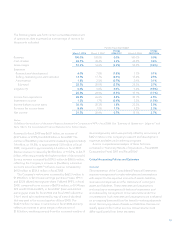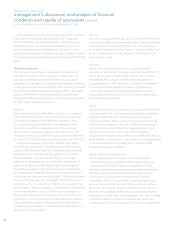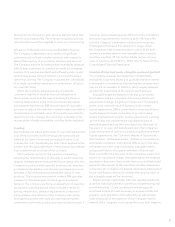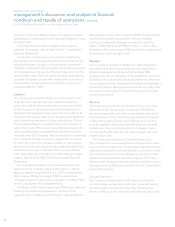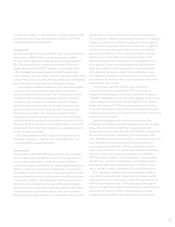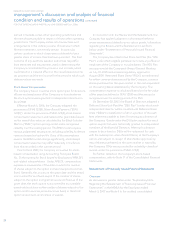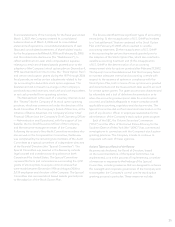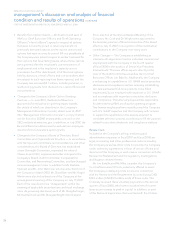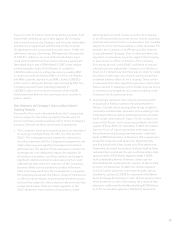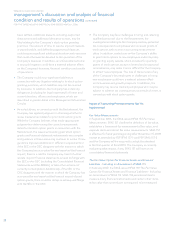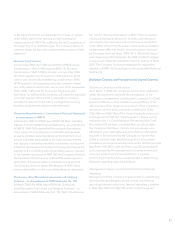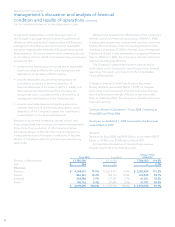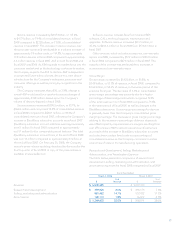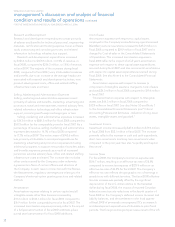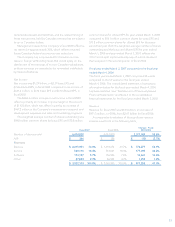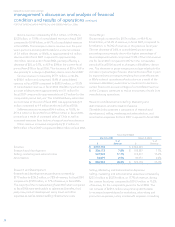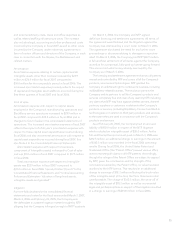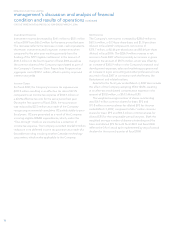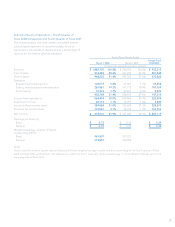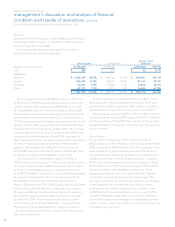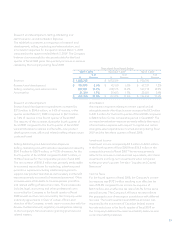Blackberry 2008 Annual Report Download - page 31
Download and view the complete annual report
Please find page 31 of the 2008 Blackberry annual report below. You can navigate through the pages in the report by either clicking on the pages listed below, or by using the keyword search tool below to find specific information within the annual report.29
at fair value. If elected, unrealized gains or losses on certain
items will be reported in earnings at each subsequent
reporting period. SFAS 159 is effective for the Company as of
the beginning of its 2009 fiscal year. The Company does not
intend to adopt the fair value measurement provisions of this
statement.
Business Combinations
In December 2007, the FASB issued SFAS 141(R) Business
Combinations. SFAS 141(R) replaces SFAS 141 Business
Combinations. SFAS 141(R) is broader in scope than SFAS
141 which applied only to business combinations in which
control was obtained by transferring consideration. SFAS
141(R) applies to all transactions and other events in which
one entity obtains control over one or more other businesses.
SFAS 141(R) is effective for fiscal years beginning after
December 15, 2008 and the Company will adopt the standard
in the first quarter of fiscal 2010 and its effects on future
periods will depend on the nature and significance of any
business combinations subject to this statement.
Noncontrolling Interests in Consolidated Financial Statements
– an amendment of ARB 51
In December 2007, the FASB issued SFAS 160 Non-controlling
Interests in Consolidated Financial Statements – an amendment
of ARB 51. SFAS 160 requires that the noncontrolling interest
in the equity of a subsidiary be accounted for and reported
as equity, provides revised guidance on the treatment of net
income and losses attributable to the noncontrolling interest
and changes in ownership interests in a subsidiary and requires
additional disclosures that identify and distinguish between the
interests of the controlling and noncontrolling owners. Pursuant
to the transition provisions of SFAS 160, the Company will adopt
the standard in the first quarter of fiscal 2010 via retrospective
application of the presentation and disclosure requirements.
The Company does not expect the adoption of SFAS 160 to
have a material effect on the consolidated financial statements.
Disclosures about Derivative Instruments and Hedging
Activities – an Amendment of FASB Statement No. 133
In March 2008, the FASB issued SFAS 161 Disclosures
about Derivative Instruments and Hedging Activities – an
Amendment of FASB Statement No. 133. SFAS 161 enhances
the current disclosure framework in SFAS 133 and requires
enhanced disclosures about why an entity uses derivative
instruments, how derivative instruments are accounted for
under SFAS 133 and how derivative instruments and related
hedged items affect an entity’s financial position, financial
performance and cash flows. SFAS 161 is effective for fiscal
years beginning after November 15, 2008 and the Company
is required to adopt the standard in the first quarter of fiscal
2010. The Company has not yet assessed the impact the
adoption of SFAS 161 would have on its consolidated financial
statements.
Disclosure Controls and Procedures and Internal Controls
Disclosure Controls and Procedures
As of March 1, 2008, the Company carried out an evaluation,
under the supervision and with the participation of the
Company’s management, including the Company’s Co-Chief
Executive Officers and its Chief Accounting Officer, of the
effectiveness of the design and operation of the Company’s
disclosure controls and procedures, as defined in Rules
13(a)-15(e) and 15(d)-15(e) of the United States Securities and
Exchange Act of 1934 (the “Exchange Act”). Based on that
evaluation, the Co-Chief Executive Officers and the Chief
Accounting Officer have concluded that, as of such date,
the Company’s disclosure controls and procedures were
effective to give reasonable assurance that the information
required to be disclosed by the Company in reports that
it files or submits under the Exchange Act is (i) recorded,
processed, summarized and reported, within the time periods
specified in the SEC’s rules and forms, and (ii) accumulated
and communicated to management, including its principal
executive and principal financial officers, or persons
performing similar functions, as appropriate to allow timely
decisions regarding required disclosure.
Management’s Report on Internal Control Over Financial
Reporting
Management of the Company is responsible for establishing
and maintaining adequate internal control over financial
reporting. Internal control over financial reporting is defined
in Rule 13(a)-15(f) and 15(d)-15(f) under the Exchange Act


